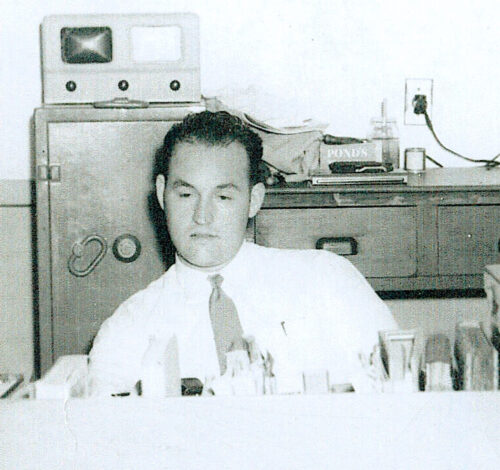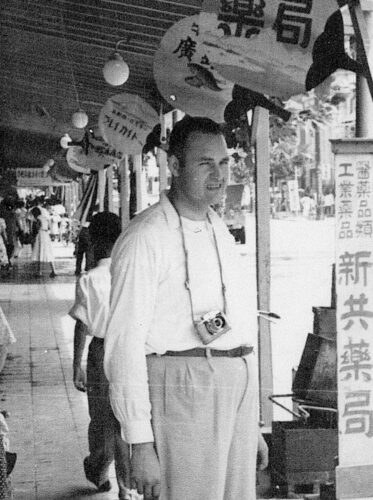Big Smoke Writes His Boss

(‘Big Smoke’ Tom Duvall at his desk in Yokosuka, Japan, 1950. There were challenges in The Occupation, and some of them came from a variety of directions).
Editor’s Note: The missive below is from “Big Smoke” LCDR Tom Duval, USN-Ret., to a former Director of Naval Intelligence. For many of us, that DNI defined the spirit of the age in which he served. He wore the uniform with dignity and managed with aplomb the affairs of the Nation’s first designated “intelligence” organization. Navy had chartered Lieutenant Theodorus Bailey Myers Mason in 1882 to manage an office intended to conduct a variety of useful tasks and purposes. Other organizations followed the lead. The War Department- “Army”- periodically had need for spies and espionage, but those were handled by forces in the field. When those forces returned to garrison, the need for spying was minimized, and no standing organization was maintained across the nation’s conflicts.
In the 141 years since Navy chartered an Office of Intelligence, there are now about 17 such organizations in our Government. The activities of this group we now call “The Intelligence Community (IC),” has been much in the news of late for a variety of activities. Some of them may not have been “useful.” Navy’s Office of Naval Intelligence was followed in short order by one established in the Army, under the Department of War.
In addition to these two cabinet positions, the State Department always had reporting requirements, and was a third Intelligence producer and consumer. The Department of Justice itself is a new organization, having been established in 1870. By 1908, the Attorney General decided he required specialized intelligence for law enforcement. Thus began the organization we know today as the FBI.
There could be more members of the IC this morning. We hesitate to say that definitively, since things may have changed overnight. As an example, one member of our Writer’s Section completed government service with an assignment to help the Department of Health and Human Services set up a departmental intelligence organization. A little incongruous for a social welfare organization, to be sure. But that task stemmed from the fact that some of the Public Health organizations it supervises- like CDC, for example- recently demonstrated a national security role in combatting threats posed by pandemics. Those could, as demonstrated, be natural or man-made in origin.
Along the way to our current situation were major international conflicts against Spain, involvement in The Great Wars, One and Two, a Cold One that included battle in Korea and Vietnam, a couple Persian Gulf conflicts and an assortment we called a “Global War on Terror.”)
Publishing Big Smoke’s note tells part of the story of how we arrived with our current array of Spies. The letter below is presented complete, as part of the marshaling of surviving memories about what we call “The Big Change.” Here is Big Smoke in the black market district of Yokosuka in 1950, alert for evidence of malfeasance:

(There was commentary yesterday about how official photos were best staged. Big Smoke’s official photo we ran yesterday includes something including vague menace. You can see from the casual picture above that Tom provided it was quite accurate in how he looked on the job.)
1/24/08
Dear Sir,
Last December I finished my work for Andy Marshall, and that ended my work for Uncle Sam from 1944 to 2007. I have moved up to the “farm” and have now tried to start writing my life story. Many in the Navy and Pentagon have been after me to do so. As I remember incidents, I have been writing them up and from the enclosed you will see that no official Navy publication would print it.
I had not realized that my Mother had kept so many of the pictures I had sent her.
At seventeen I entered the Navy in 1944. In 1945, I made BM3 one month before all promotions were frozen. In 1949, I was on the USS Mount McKinley. I had been taking correspondent courses in Criminal
Investigation and all related courses the Marine Corp Institute had to offer.
With three weeks to go on my enlistment, the XO called me in and said that SERVPAC had looked at my record and if I would extend my enlistment, they had a job in Police Work for me in Japan. I knew about the Army CID there and I assumed this was Naval Intelligence.
I agreed to take the job and two weeks later it was Priority Air across the Pacific. It only took about five days at that time.
At Navy Far East (NAVFE) I reported to CAPT Stone, the Intelligence Officer. At that time our Intelligence West of Hawaii was about five officers and five enlisted men. Stone got right to the point: Navy had to clean up the mess in the Naval Zone or the Army would take it over. He said that I would be going down to Yokosuka as supervisor of Japanese Police and would also handle any investigations required.
He said that my immediate boss would be the area Provost Marshal, Colonel A. Bryan Lasswell, who also was CO of the Marine Barracks. Lasswell was fluent in Japanese, and I am sure that RADM Showers knew him.
CAPT Stone told me that I had better get some civilian clothes, since rank had no place in this job.
I then reported to Colonel May, General MacArthur’s Provost Marshal. He was a tough old bird who made it very clear what I was to do. Those who had been supervising the police were in the brig for black marketing and most of the senior officers in the area were also making money on the side. He said I would be contacted by Army CID and I would was to work with them.
He then sent me on to the Army CID Lab for extensive instruction in collection and preservation of evidence and working with Japanese Police.
The rest is history. VADM Briscoe gave me a medal, but it was for work after the Peace Treaty was signed. He liked my evening tours of the back alleys of Yokosuka. The period from 1949 to 1951 is something I will have to write up.
As you can see from the enclosed, “The Cracker Caper” is not something the NIP Quarterly would print.
Keep Well,
Tom D
(Gentle Readers, the Cracker Caper told by Big Smoke is part of a larger story being assembled today. It is not intended to be a footnoted history. Much has already been written in that fashion. This is intended to depict the way things were and how they unfolded since the Big Change in 1947. It is told by people who were there to experience it. Tom’s note to the DNI is called “The Cracker Caper.” It depicts how an energetic intelligence officer can use materials available to answer emerging challenges. Back then, the forces confronting those matters amounted to Tom, five other officers and five enlisted troops west of Pearl Harbor.
Considering those changes from a nation at total war to one navigating an uncertain peace, the information may be useful to us today. The news this morning of the arrest of a senior FBI special agent who spearheaded the Trump-Russia probe is a case in point. Charles McGonigal has been charged over his own alleged ties to a sanctioned Russian oligarch. He retired in 2018 amid the prospects of war in Ukraine. Discussion around the circle concerned how far in advance of his leaving government service he began organizing his own un official retirement. And that, Gentle Readers, is why we are going to plow some of this old ground again!)
Copyright 2023 Vic Socotra
www.vicsocotra.com
